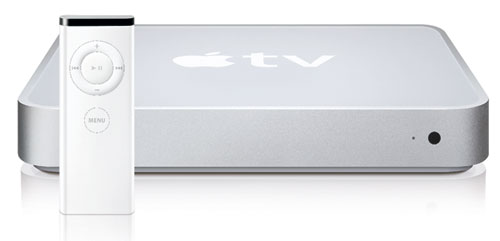 It's been a while since I said much about my (count 'em, two) Apple TV units. About time I rectified that ...
It's been a while since I said much about my (count 'em, two) Apple TV units. About time I rectified that ...In case you missed it — admittedly, an easy thing to do — Apple's Steve Jobs unveiled the Apple TV in Sept. 2006 as a sort of home theater-connected iPod on steroids. You were expected to connect the petite box, less than eight inches square, to a TV or home theater system. Then iTunes on your computer would sync songs, videos, podcasts, photos, and other digital content to it's hard drive, just as with an iPod or iPhone. You could then play that content through your home entertainment system and/or HDTV.
Apple shipped the first Apple TVs in March 2007 — to deafening silence, aside from the technorati, most of whom held their collective noses. Sales were abysmal. I won't detail all the complaints of that time, but the main issue was that Apple TV didn't do enough, and it did what it did slowly, unreliably, and generally badly.
Over the last 2 1/2 years, Apple has slowly addressed the gripes (most of them). Apple TV is now a pretty good product, and in the fourth quarter of 2008, as the economy was tanking, sales were actually triple those of the fourth quarter of 2007.
The Apple Store's Apple TV page currently shows the product at $229.00 with a 160-GB internal hard drive, the original 40-GB model having been retired. (The fact that the internal drive is so small by today's standards is less of an issue than you might think, because Apple TV easily streams iTunes content that doesn't reside on it.)
In 2007 Mr. Jobs famously (?) spoke of the Apple TV as a "hobby" of the folks at Apple, Inc., not a full-fledged business. The Mac, the iPhone/iPod, the iTunes Store — they're real businesses, Jobs said. Apple TV was something of a household pet in Cupertino. He of course was right about that.
That may change — not real soon, but in the not too distant future. This blogger thinks it will and hopes it does. The key will be that Apple TV is now seen by Apple more as an all-purpose media client, and less as an iPod on steroids.
This paragraph from the Wikipedia article on Apple TV gets at what I mean:
With the "Take Two" software update announced by Steve Jobs at Macworld 2008, Apple TV became capable of acting as a pure stand-alone device, no longer requiring a computer running iTunes on Mac OS X or Windows to stream or sync content to it. Jobs stated, "Apple TV was designed to be an accessory for iTunes and your computer. It was not what people wanted. We learned what people wanted was movies, movies, movies." Users can access the iTunes store directly through Apple TV to purchase movies, music, music videos, and television shows. Customers can also use Apple TV to rent standard or HD-quality movies. Until mid-March 2009, iTunes HD movies could only be purchased from Apple TV.
If your computer goes down, or if iTunes is not running, the only thing you lose is the ability to stream — not sync, but stream — content from it to Apple TV. You can still play your previously synced video, audio, and photo content (as long as it resides on Apple TV's hard drive; if not, Apple TV does want to stream it from iTunes instead). You can still grab content, including HD movies and TV shows, from the iTunes Store directly. You can still play YouTube videos and listen to Internet radio stations (this last being a welcome new feature).
OK, so Apple TV has become a real product, in my eyes at least. Herein, a potpourri of cool stuff about it:
 First, there is now a neat iPhone/iPod Touch app called (naturally) Remote (web page here; App Store download link here) that turns your mobile device's touch screen into a way to control an Apple TV. It's free, and it works. It presents the iPhone/iTouch user with an interface very much like the iPod app itself, with the addition of a Control tab that does what Apple TV's Apple Remote does, but more easily and intuitively.
First, there is now a neat iPhone/iPod Touch app called (naturally) Remote (web page here; App Store download link here) that turns your mobile device's touch screen into a way to control an Apple TV. It's free, and it works. It presents the iPhone/iTouch user with an interface very much like the iPod app itself, with the addition of a Control tab that does what Apple TV's Apple Remote does, but more easily and intuitively. The Control tab in effect turns your touch screen into an Apple TV remote control. You drag your finger along the touch screen, either side-to-side or up and down, to do what the Apple remote (-->) does with its control ring and central Play/Pause/Select button.
The Control tab in effect turns your touch screen into an Apple TV remote control. You drag your finger along the touch screen, either side-to-side or up and down, to do what the Apple remote (-->) does with its control ring and central Play/Pause/Select button. The Apple Remote's Menu button, meanwhile, is replaced by a virtual Menu button (<--) in the Remote App — I'll call the app RA for short. The RA > or Exit button brings up various tabs for exiting the Control Tab and accessing "Playlists," an "Artists" list, a "Search" function, and "More": Albums, Audiobooks, Composers, Genres, Movies, Music Videos, Podcasts, Songs, and TV Shows.
The Apple Remote's Menu button, meanwhile, is replaced by a virtual Menu button (<--) in the Remote App — I'll call the app RA for short. The RA > or Exit button brings up various tabs for exiting the Control Tab and accessing "Playlists," an "Artists" list, a "Search" function, and "More": Albums, Audiobooks, Composers, Genres, Movies, Music Videos, Podcasts, Songs, and TV Shows.In the right-bottom corner is an Options button used to display on your TV Apple TV commands: basically, Start Genius, Add to On-The-Go, Browse Artist, Browse Album, and Cancel.
RA also controls iTunes playback. If (as I do) you have Airport Express units installed on your home network and connected to your home entertainment center(s), RA can tell iTunes to select among those and your computer's own speakers.
In fact, RA seems in some sense to be leveraging the ability of Apple TV to turn itself into an AirTunes device, à la an Airport Express. I don't fully understand what's going on ... but never mind. The important thing is that RA controls Apple TV (or iTunes itself) wirelessly, using WiFi. Unlike with the the infrared Apple Remote, you don't have to be in the same room with Apple TV or a computer running iTunes. That's marvelous. I like to start music playing and wander (with my iPhone) into a different room. RA can direct operations truly remotely, even to the extent of letting me turn up or down the volume when need be, from anywhere in your house.
Another cool thing: RA displays, on the iPhone/iTouch's screen, the cover art of the music you're playing on Apple TV! Cover art also appears next to songs, albums, etc., as you flip through them in RA, looking for something to play.
Here is the take Christopher Breen of Macworld had on RA. (I'm not precisely sure what "Oooh" and "Feh" mean in his lexicon, BTW ... )
The next item in my Apple TV potpourri is about a neat website, Apple TV Junkie. ATVJ covers Apple TV in depth. I especially like its The More You Know page, where you can learn about such things as:
- Using Third-party Remote Controls With Apple TV
- Using AirTunes With Apple TV
- Apple Remote Pairing
- Streaming Photos From Applications To Your Apple TV
- Streaming Radio On Your Apple TV (Apple TV 3.0 now does this effortlessly.)
- Hacking the AppleTV: Get Your Boxee On (Boxee is a gateway to all sorts of online content not officially supported by Apple. To put it on Apple TV requires a "hack" though. The ATVJ article tells you how.)
- Boxee Blog & Boxee On Twitter
- Get The Super Bowl Theatrical Spots In HD On Your Apple TV
- DIY Apple TV Home Media Server
- Movie Rental Video Formats
- Using Chapter Selection In Apple TV
- Removing Menu Items from the Apple TV
Check it out!





















